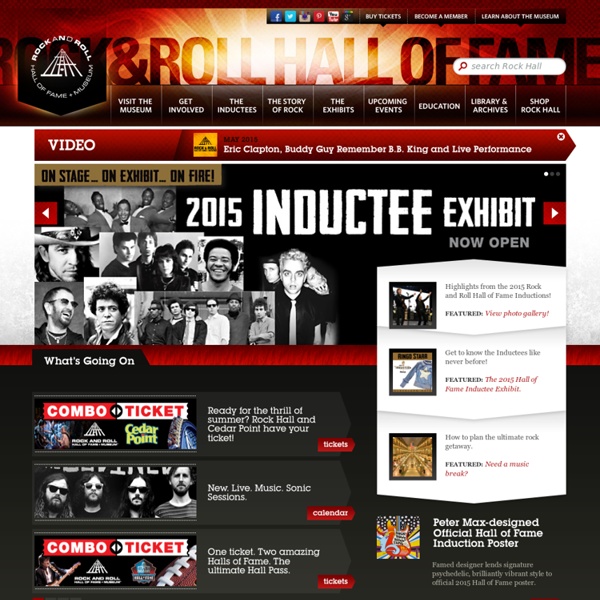



History of Rock & Roll The songs and the sounds we call "rock and roll" evolved from many different sources, in many different regions, and at many different moments in twentieth- century history. The music was shaped—and continues to be molded and transformed—by countless regular people, some doing what they love, others seeking refuge from what they hate, some hoping to change the world, and still others resisting what they fear. How many times per week would you say you hear someone refer to "rock and roll" in some form or another? So the next question is, do you like rock and roll? Or maybe you're saying, "Yes, I love rock and roll—I eat, sleep, breathe it. What exactly is "rock and roll" then, you ask. You might be surprised by the answers to these questions... and, really, the whole story of how rock and roll came to be. People who Shmooped this also Shmooped...
The Official Website Blues Music History Sometime around 1890, the blues emerged as a distinct African-American art form, rooted in the southern U.S. and drawing on work songs and hollers, folk tradition, black spirituals, and the popular music of the time. Looking back from 1890, one can speculate about the African influence in the musical structure of the blues as it grew from slave culture and the memory of slavery. Looking forward from 1890, a time of transition in America and of dashed hopes for blacks in the resurgent Jim Crow South, one can see the blues as a powerful force both shaping and shaped by the evolution of American popular culture (from the "race records" craze of the 1920s through the blues-fueled rock revolution of the postwar years) and the history of black and white race relations in the century ahead. "The blues ain't nothing but a good man feelin' bad." That's what Leon Redbone said, anyway, and who can't relate to that? What about when your parents went crazy for Elvis?
Achilles Last Stand - The Led Zeppelin Website The Blues The Blues™ anchors a multi-media celebration that raises awareness of the blues and its contribution to American culture and music worldwide. Under the guiding vision of Executive Producer Martin Scorsese, seven directors will explore the blues through their own personal styles and perspectives. The films in the series are motivated by a central theme: how the blues evolved from parochial folk tunes to a universal language. The seven-part film series includes: Feel Like Going Home by Martin Scorsese The Soul of a Man by Wim Wenders The Road to Memphis by Richard Pearce Warming by the Devil's Fire by Charles Burnett Godfathers and Sons by Marc Levin Red, White & Blues by Mike Figgis Piano Blues by Clint Eastwood
Cory Branan - The Corner Chicago: The Best Blues Bars : Music And Festivals 'Man playing saxophone' As Robert Johnson said, Chicago is a "sweet home" for the blues. The emergence of blues culture in the Windy City began in the 1920s and coincided with a nationwide increase in musical performance and recording. This culture is alive and kicking today, and that's why we're taking you to five of Chicago's hottest blues bars. Blue Chicago Blue Chicago in the city's North River district has been a local favorite for over 12 years. For visitors, this is a great place to learn the story of Chicago blues. The club actually has 2 locations and between the 2 clubs you can hear blues musicians and vocalists every night of the week and one cover charge is good at both. Rosa's Lounge The New York Times calls Rosa's the best blues bar in Chicago and that's good enough for us. One more reason to spend at evening with Tony and Mama Rosa is the food. Lee's Unleaded Blues On Chicago's Southside, Lee's Unleaded Blues is serving up authentic, old-school Chicago Blues.
PAX•AM Antebellum Period Our historical understanding of antebellum America is heavily colored by our knowledge of the disaster that brought that era of American history to a close: the Civil War. But the people who lived through the antebellum period had no way of knowing that historians would later define their era by the war that ended it. ("Antebellum" is Latin for "pre-war.") Antebellum Americans did, however, understand and appreciate the seriousness of the increasing sectional conflict dividing the country between the slave-labor, agricultural South and the "free labor," industrializing North. Antebellum culture in America reflected the growing sectional crisis, at times seeking to pave over sectional differences and at other times making light of them. Congressmen pushed through a "gag rule" so that the difficult subject of slavery would simply be made taboo in the chambers of government. If you want to understand antebellum American culture, from the familiar to the outlandish, read on.
Van Morrison - Official Website | Van Morrison tours, songs, concerts ...